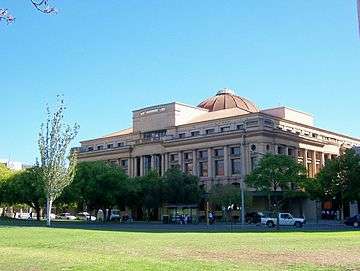Samuel Way


Sir Samuel James Way, 1st Baronet (11 April 1836 – 8 January 1916), English-Australian jurist, was a Chief Justice of the Supreme Court of South Australia from 18 March 1876 until 8 January 1916.
Background
Way was born in Portsmouth, England. Reverend James Way, his father, was a clergyman in the Bible Christian Church, who emigrated to Adelaide, South Australia in 1850 along with his wife and four younger children to establish a mission. Samuel, the eldest child, remained behind, studying at Shebbear College in Shebbear, a small village in North Devon, and later at a school in Chatham in Kent. He left England to rejoin his family at the end of 1852, arriving in Adelaide in March 1853. He was soon employed in the office of John Tuthill Bagot, at that time a barrister, and in 1856 became an articled clerk to Alfred Atkinson (c. 1825 – 4 June 1861), solicitor of King William Street.[1]
Legal and judicial career
On 25 March 1861, Way was admitted to the South Australian Bar to practice law, and when Atkinson died shortly afterwards, Way inherited his practice.[1] Way practised as a barrister and quickly became a leader among the legal community, and in 1868 joined a partnership with another barrister, James Brook.[2] In September 1871, Way was made a Queen's Counsel, despite having been admitted to the bar only ten years earlier. When Brook died in 1872, a young Josiah Symon joined Way as partner. Way continued to be highly successful, travelling to London to argue a number of cases before the Judicial Committee of the Privy Council. In 1874, Way was elected as a member of the council of the University of Adelaide, and was also appointed to the South Australian Board of Education.[1]
In 1875, Way was elected to the South Australian House of Assembly as the member for Sturt, and on 3 June of that year joined the Boucaut government as Attorney-General of South Australia. He was only a politician for a short time, however, since in March 1876, at the age of just thirty-nine, he was appointed Chief Justice of South Australia following the death of Richard Hanson on 4 March. Since it is the role of the Attorney-General to recommend judicial candidates to the cabinet, it has been suggested that Way probably nominated himself to be Chief Justice.[3] Way soon gained a reputation as an excellent lawyer, and it has been said that none of his decisions were ever successfully appealed to a higher court.[4] Later in 1876 he was appointed as the vice-chancellor of the University of Adelaide, and in 1883 became the chancellor, a position he would hold until his death.
In 1877, Way was called upon to act as acting Governor of South Australia. In January 1891 he was appointed to the position of Lieutenant-Governor of South Australia, a position subordinate to the state Governor. In January 1897, Way became the first Australian to be appointed to the Judicial Committee of the Privy Council. In 1899 he was created a Baronet, of Montefiore, North Adelaide, and Kadlunga Mintaro, both in the Colony of South Australia.[5]
Way was a Freemason and Grand Master of the Grand Lodge of South Australia and Northern Territory from 1884 to 1916, apart from the period 1889–95 when the position was occupied by the Governor, the Earl of Kintore.[6]
Personal life
Way married Mrs. Katherine Gollan Blue (née Gordon) on 11 April 1898.[7] She was the widow of Dr. William Archibald Sinclair Blue (died 18 September 1896) of Strathalbyn.[8] He became ill in 1914, and was diagnosed with cancer. He travelled to Sydney in order to have his arm amputated, in an attempt to delay the cancer, but it failed to prevent his health from deteriorating, although he continued to work as Chief Justice until December 1915. He died early the following year in North Adelaide.
Recognition

The baronetcy became extinct on his death. The geological feature Mount Sir Samuel and the town of Sir Samuel in the Goldfields region of Western Australia were named after him.
A statue was unveiled on 17 November 1924, located on North Terrace, Adelaide in front of the University of Adelaide.[1]
The Sir Samuel Way Building on Victoria Square, Adelaide was originally a major retail outlet for Charles Moore and Co. In 1983 it became a facility of the City Courts and was named after him.
See also
References
- 1 2 3 4 "A Distinguished Citizen". The Register (Adelaide: National Library of Australia). 18 November 1924. p. 10. Retrieved 14 December 2012.
- ↑ "Out Among the People.". The Advertiser (Adelaide: National Library of Australia). 20 July 1954. p. 4. Retrieved 13 December 2012.
- ↑ "Our first Grand Master, Bro Samuel J Way". Freemasons South Australia and Northern Territory. Retrieved 2006-03-02.
- ↑ Serle, Percival (1949). "Way, Samuel". Dictionary of Australian Biography. Sydney: Angus and Robertson.
- ↑ The London Gazette: no. 27174. p. 1791. 16 March 1900.
- ↑ Past Grand Masters of The Grand Lodge of South Australia and Northern Territory Accessed 4 May 2015.
- ↑ "Marriage of the Chief Justice". South Australian Register (Adelaide: National Library of Australia). 11 April 1898. p. 4. Retrieved 13 December 2012.
- ↑ "Family Notices.". Southern Argus (Port Elliot, SA: National Library of Australia). 24 September 1896. p. 2. Retrieved 22 May 2015. W. A. Blue was father of Shylie Katharine Blue (1882-1959) mother of Henry Way Rymill.
Bibliography
- Hannan, A. J., C. M. G., Q. C., The Life of Chief Justice Way, Angus and Robertson, Sydney, 1960.
- Emerson, Dr. John, First Among Equals, University of Adelaide Barr Smith Press, Adelaide, 2004, pp 11–56.
| Legal offices | ||
|---|---|---|
| Preceded by Richard Hanson |
Chief Justice of South Australia 1876–1916 |
Succeeded by George Murray |
| Baronetage of the United Kingdom | ||
| New title | Baronet (of Montefiore and Kadlunga Mintaro) 1899–1916 |
Extinct |